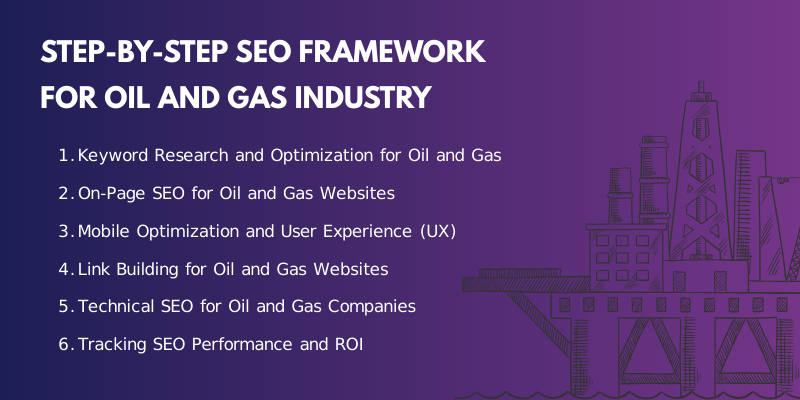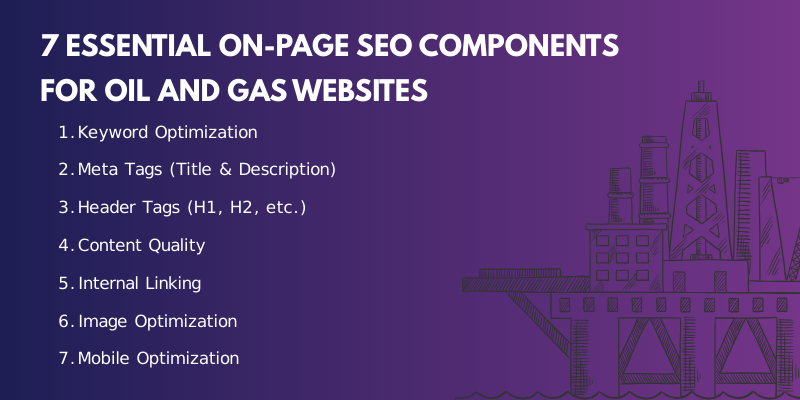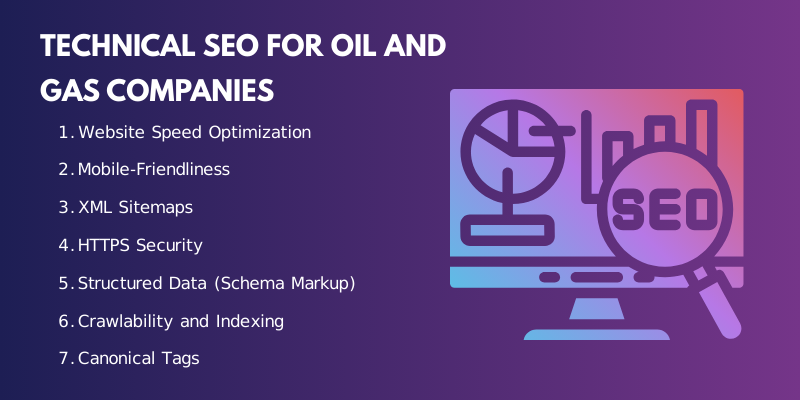SEO strategies for oil and gas companies have become increasingly important as the industry embraces the digital transformation.
Traditionally, the oil and gas sector relied on established networks and in-person interactions to build relationships and drive business.
However, as the industry evolves, digital marketing has taken center stage, enabling companies to reach a broader audience and engage more effectively with potential clients.
The growing importance of digital marketing within the oil and gas sector is undeniable. With more stakeholders, including clients, suppliers, and investors, turning to online platforms to search for services and information, establishing a robust online presence is critical.
SEO plays a key role in improving online visibility, ensuring that oil and gas companies appear at the top of search results when potential clients search for industry-specific services.
Through well-optimized websites and digital content, businesses can engage customers more effectively, drive quality traffic, and increase conversion rates.
This guide will walk you through proven SEO strategies for oil and gas companies.
Understanding SEO for the Oil and Gas Industry
Only 30% of oil and gas companies have successfully scaled digital technologies to deliver meaningful improvements.
Implementing agile digital marketing strategies, including optimizing paid search (SEM) and maximizing organic search (SEO), are among the best practices observed in successful digital transformations within industrial sectors.
As more companies in this sector shift to digital platforms, SEO becomes essential for enhancing online visibility, driving relevant traffic, and engaging potential clients.
Additionally, businesses seeking to improve their SEO performance might consider SEO audit pricing to understand the costs associated with ensuring their websites are fully optimized.
SEO is vital for visibility and lead generation in the oil and gas industry because it helps companies rank higher on search engine results pages (SERPs).
With more decision-makers relying on Google and other search engines to find vendors, services, and information, companies that prioritize SEO are more likely to attract qualified leads.
Step-by-Step: 7 SEO Strategies for Oil and Gas Companies
The competitive advantages of SEO in the oil and gas sector are immense. Thus, effective SEO strategies allow companies to differentiate themselves from competitors, making it easier to attract attention in a crowded marketplace.

High visibility in search results drives more traffic, increases the chances of lead conversion, and helps businesses capture potential clients at the moment they’re seeking solutions.
By consistently appearing at the top of search results for relevant industry keywords, companies can establish credibility and authority, fostering long-term business growth and success.
SEO services from an expert oil and gas marketing agency can further amplify these efforts.
Here’s a step-by-step framework for SEO strategies for oil and gas companies:
1. Keyword Research and Optimization for Oil and Gas
Keyword research is a foundational aspect of any successful SEO strategy. For oil and gas companies, SEO strategies for oil and gas companies involve identifying industry-specific keywords to ensure that their digital content reaches the right audience.
Utilizing tools like SEO audit tools and Google keyword ranking software can streamline this process and enhance your keyword selection.
By targeting the right keywords, companies can attract potential clients actively searching for their specific services, whether it's exploration, production, or energy solutions.
These keywords help attract decision-makers, contractors, suppliers, and other stakeholders who are actively searching for services and solutions in the energy sector.
Here are some key steps taken for keyword optimization:
Identifying Industry-Specific Keywords
In the competitive oil and gas market, using the right keywords is essential for standing out in search results. Industry-specific keywords, such as “oil field services,” “energy solutions,” or “oil and gas contractors,” allow companies to target the exact needs of potential clients.
By focusing on these terms, businesses can optimize their content to match search intent, ensuring that their website appears in front of people actively looking for what they offer.
Effective Keyword Research in the Oil and Gas Sector
To conduct effective keyword research, oil and gas companies should start by analyzing what terms their target audience is searching for.
This can be done by using tools like Google Keyword Planner, SEMrush, or Ahrefs to identify high-volume and relevant keywords.
Understanding competitors' keywords and researching long-tail keywords (more specific phrases) can also reveal untapped opportunities.
It's important to focus on keywords that are not only high in search volume but also directly related to the services or solutions the company provides.
Optimizing Content for High-Value Keywords
Once industry-specific keywords have been identified, it’s essential to optimize the content for these terms. This includes incorporating them naturally into page titles, headers, meta descriptions, and throughout the content itself.
This ensures search engines can easily identify and rank the content for the appropriate search queries. Furthermore, using variations and related terms, such as “oil exploration services” or “energy sector solutions,” can help capture a broader audience and improve content relevance.
2. On-Page SEO for Oil and Gas Websites
On-page SEO is a critical factor in ensuring that oil and gas websites rank well on top search engines and provide a seamless user experience. Leveraging SEO ranking report software can help track progress and highlight areas for improvement.
By optimizing key elements of the website, companies can improve visibility, enhance user engagement, and drive conversion.

Here are 7 essential on-page SEO components for oil and gas websites:
- Keyword Optimization: Identifying and using relevant keywords throughout the website’s content, including titles, headings, and body text, to ensure the site ranks for industry-specific terms.
- Meta Tags (Title & Description): Crafting compelling and optimized meta titles and descriptions with target keywords. These are important for search engines and improving click-through rates from search results.
- Header Tags (H1, H2, etc.): Organizing content with clear, hierarchical header tags that help both search engines and users understand the structure of the page and its main topics.
- Content Quality: Providing high-quality, informative, and relevant content that answers user queries. It should be authoritative and aligned with industry trends, establishing the company as a thought leader.
- Internal Linking: Using internal links to connect relevant pages within the website, improving navigation, helping with content indexing, and distributing link equity to important pages.
- Image Optimization: Compressing and resizing images for faster loading times and adding relevant alt text to improve accessibility and enable search engines to understand the image content.
- Mobile Optimization: Ensuring the website is fully responsive, providing an optimal browsing experience across devices. This is critical for both user experience and for ranking well with Google’s mobile-first indexing.
These On-Page SEO components are essential for oil and gas websites to improve visibility, drive targeted traffic, and enhance user experience. These on-page SEO components are essential for oil and gas websites to improve visibility, drive targeted traffic, and enhance user experience, ensuring that businesses stay competitive in the SEO vs PPC debate.
3. Mobile Optimization and User Experience (UX)
Mobile optimization and user experience (UX) are crucial for ensuring that SEO strategies for oil and gas companies are successful in ranking well in top search engines while offering a seamless experience for visitors. Implementing onsite and technical SEO practices will help maintain an efficient and mobile-friendly site.
A mobile-optimized website enhances the user experience, which directly contributes to improved SEO performance and higher search rankings.
As more users access websites through mobile devices, ensuring that oil and gas websites are mobile-friendly is essential for attracting and retaining visitors, ultimately driving business success.
For oil and gas websites, where technical content and service offerings need to be easily accessible, a mobile-optimized site ensures users can find the information they need, whether they’re on-site or in the field.
Here are some of the best practices you must consider:
- Page Speed: Fast loading times are critical for both SEO and UX. Slow pages can cause frustration, leading to higher bounce rates and lower rankings. Optimizing images, reducing file sizes, and leveraging caching can significantly improve page speed.
- Navigation: Clear, intuitive navigation helps users find information quickly, which enhances their experience. For oil and gas websites, this might mean having clearly labeled service pages, an accessible contact page, and easy-to-use menus that guide users to the content they need.
- Responsive Design: Ensuring the website adapts to various screen sizes and devices is a fundamental aspect of mobile optimization. A responsive design ensures a consistent user experience across desktop, tablet, and mobile devices.
Get Your Free SEO Audit Report Today!
4. Link Building for Oil and Gas Websites
Link building is a vital aspect of SEO, especially in the oil and gas industry, where establishing authority and credibility is essential for standing out in a competitive market.
By leveraging advanced link building and collaborating with high-authority websites, you can significantly boost your SEO performance.
High-quality backlinks not only drive referral traffic but also improve search engine rankings, enhancing visibility and trust.
The following steps are required for link building on an oil and gas website
Strategies for Acquiring High-Quality Backlinks in the Energy Sector
To acquire high-quality backlinks, oil and gas companies should focus on creating valuable, shareable content that attracts links from reputable sources.
Utilizing programmatic SEO can also automate this process to scale link-building efforts.
This could include in-depth industry reports, whitepapers, and case studies that offer insights into the energy sector. Additionally, companies can reach out to industry influencers, collaborators, and business partners for backlink opportunities.
Leveraging guest blogging or contributing articles to established platforms can also be a great way to build backlinks.
Enhances Authority and Search Rankings for Link Building
Backlinks from authoritative, trusted websites act as endorsements for your content, signaling to search engines that your website is a credible source of information.
The more high-quality backlinks a website has, the higher its domain authority, which leads to better rankings in search results.
For oil and gas websites, obtaining backlinks from respected industry websites and publications can significantly boost search visibility and attract more qualified traffic.
Collaborating with Industry Publications and Organizations for Backlinks
Collaborating with industry publications, energy associations, and organizations is an effective way to earn high-quality backlinks.
By contributing guest posts, sharing insights, or participating in joint initiatives, oil and gas companies can build relationships with influential platforms that can link back to their websites. These backlinks not only improve SEO but also position the company as a thought leader in the energy sector.
5. Technical SEO for Oil and Gas Companies
Technical SEO is a critical component of any SEO strategy, especially for oil and gas companies looking to improve their website’s performance, security, and visibility on search engines.

It involves optimizing the technical aspects of a website to ensure it meets the standards set by search engines like Google, improving user experience and enhancing search rankings.
Here are the most important technical SEO components for oil and gas companies:
- Website Speed Optimization is crucial, as fast-loading websites improve both user satisfaction and search engine rankings. Google prioritizes speed, and slow websites can lead to higher bounce rates.
- Mobile-Friendliness has become essential with mobile-first indexing by Google. Ensuring that a site is responsive and performs well on mobile devices is vital to stay competitive.
- XML Sitemaps allow search engines to easily find and index pages on the website. A properly structured XML sitemap ensures that all important content is indexed and displayed in search results.
- HTTPS Security has become a ranking factor, as Google gives preference to secure websites. It also boosts trust with visitors, especially when handling sensitive information, such as client data or inquiries.
- Structured Data (Schema Markup) helps search engines better understand the content of the website. By using schema markup, oil and gas companies can improve their visibility with rich snippets, which enhance search results with additional information.
- Crawlability and Indexing ensure that search engines can easily discover and index key pages. Ensuring proper site structure and addressing any crawl errors is vital for effective SEO.
- Canonical Tags prevent issues with duplicate content. By specifying the preferred version of a page, oil and gas companies can avoid SEO penalties and ensure that search engines index the most relevant content.
These elements are foundational to building a strong SEO strategy, enhancing visibility, and ensuring a better user experience for visitors.
Explore Our Programmatic SEO Services!
6. Tracking SEO Performance and ROI
Tracking SEO performance and measuring ROI are essential to understanding the effectiveness of your SEO efforts and justifying investments in digital marketing.
Leveraging best SEO reporting software can help oil and gas companies measure key metrics and optimize campaigns for better results.
By using the right tools and analyzing key performance indicators (KPIs), oil and gas companies can optimize their strategies and improve results over time.
KPIs help measure the effectiveness of SEO strategies. For oil and gas companies, some key KPIs include:
- Organic Traffic: The number of visitors coming to the website from search engines.
- Keyword Rankings: The positions of targeted keywords in search engine results.
- Conversion Rate: The percentage of visitors who take desired actions, such as filling out a contact form or requesting a quote.
- Bounce Rate: The percentage of visitors who leave the site after viewing only one page. A high bounce rate may indicate the need for better content or user experience.
Frequently Asked Questions
What makes SEO important for oil and gas companies?
SEO is important for oil and gas companies because it improves online visibility and helps firms show up when potential clients search for services like “oil field services” or “energy solutions.” A strong SEO strategy drives relevant traffic, attracts decision‑makers and stakeholders, and increases the chances of lead generation and business growth.
How do I choose the right keywords for an oil and gas website?
You should perform industry‑specific keyword research to find terms relevant to your services — for example “oil exploration services,” “energy sector contractors,” or “oilfield equipment suppliers.” Using keyword tools and targeting long‑tail, high‑value keywords ensures your content reaches the right audience and matches search intent.
What on‑page SEO practices work best for oil and gas companies?
Effective on‑page SEO includes using target keywords in titles, meta descriptions, headers, and body content, while also structuring pages clearly with correct heading hierarchy. Additionally, high‑quality, informative, and authoritative content helps build trust and increases the likelihood of ranking higher in search results.
Why is technical SEO and user experience vital for energy‑sector websites?
Technical SEO — like optimizing site speed, ensuring mobile responsiveness, and improving site structure — is vital because it affects how easily search engines crawl and index your site. Good user experience (fast-loading pages, intuitive navigation, mobile‑friendly design) helps retain visitors and improves engagement, which positively impacts search rankings.
How does link building and high‑quality backlinks boost SEO for oil and gas companies?
Building quality backlinks from reputable, industry‑relevant sites establishes authority and credibility for your website. These backlinks signal trust to search engines, improve domain authority, and help your oil and gas company rank higher for industry‑specific search queries.
Conclusion
SEO strategies for oil and gas companies are essential for driving long-term success in the digital landscape. As we’ve discussed, implementing effective SEO techniques such as keyword research, on-page optimization, and link building can significantly improve online visibility, attract qualified leads, and enhance user experience. Companies may also consider working with an oil and gas marketing agency or leveraging digital transformation comaonies like Centric to optimize their online presence effectively. These strategies not only help companies rank higher in search results but also build credibility and authority in the competitive energy sector.
The long-term benefits of consistent SEO efforts are clear: sustainable growth in online visibility, improved lead generation, and a strong competitive advantage. By continuously refining SEO strategies and staying up-to-date with industry trends, oil and gas companies can maintain a prominent online presence, ensuring they capture more market share over time. Oil and gas companies should adopt these strategies and consider seeking professional SEO services to maximize their digital marketing potential. A well-optimized website and ongoing SEO efforts will lead to increased traffic, higher conversions, and long-term success in the industry.









